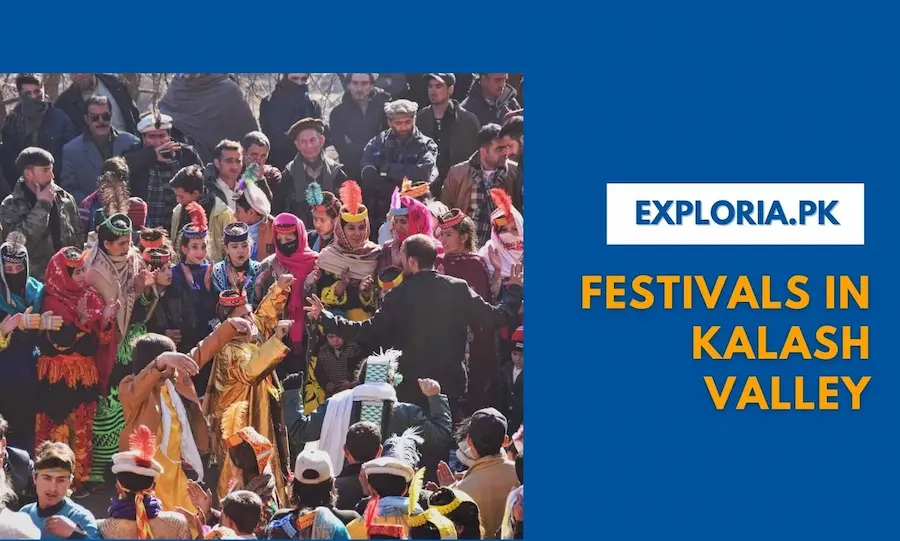Kalash Valley is an isolated valley whose dwellers had remained undetected to the outside world until 1975. The Hindukush mountains encircle the Kalash lowlands. The inhabitants of these regions are known as Kalasha people, they live therefore in the region of northern Pakistan, bunched up between highlands adhere to an ancient version of Hinduism, and have their own culture, language, and mode of life. The Kalasha have managed to hold their homeland for centuries, sustaining their freedom.
The Kalash festival is a long-standing cultural celebration that occurs annually at roughly the same time in the Kalash Valley of Pakistan. There is still much to learn about Kalash Valley in Pakistan as it continues to be a mystery. So, let’s learn a little about the Kalash Valley people and the annual cultural festivals that they celebrate.
Kalash Valley Festivals Overview
The Kalasha people observe the Kalash festivals that occur three times a year: in the spring, summer, and winter. People enjoy themselves at the festival by drinking, dancing, and generally having an enjoyable time, however, they also venerate their gods and spirits by providing offerings and even making sacrifices. Additionally, young men and women choose their future spouses during this event as well.
Kalash Valley The Festival Dates
- Chilam Joshi festival – Begins around May 13, (Springtime festival).
- Uchal Festival – Begins on August 20, (Summertime festival).
- Choimus Festival – Begins on December (Winter festival).
Kalash Valley Festivals History, Date & other Details
1. Chilam Joshi Festival (Spring Festival)
Chilam Joshi festival, also referred to as spring festival in Kalash Valley is celebrated in the middle of May. It is a four-day festival that all Kalash Valleys participate in. Milk Day marks the start of the spring festivities. They store milk from their homes ten days before the celebration.
During this occasion, Kalash residents donate their beverages, people from the Kalash tribe also dance to the beat of drums while dressed in festive attire. Women dress in traditional garb for the Kalash festival, donning brightly colored garments with floral motifs. Their headgear and clothing are complemented by the beaded necklaces that they wear. While men on the other hand, dress in the traditional Shalwar Kameez, which includes a woolen waistcoat.
The event showcases their distinct cultural diversity, community cohesion, and message of love and peace to the rest of the civilized world. They beseech their God for blessings and pray for a successful agricultural year as well as the wellbeing and safety of their livestock.
Both Kalasha men and women make some decisions about their lifestyles during this occasion as on the festival’s last day, they can choose their life mates and proclaim their names while they dance and sing as a whole community.
Uchal Festival (Summer Festival)
The inhabitants of Kalash each possess a unique method of embracing summer. The Kalasha people love to celebrate summer festivals. The Uchal festival arrives in August during the summer. This festival has become more well-known internationally in recent years. The summer festival draws a sizable audience from all around Pakistan as well as foreign visitors.
The Kalasha people celebrate the season and express gratitude to their God for providing them with food and crops as a way of showing reverence to him throughout the festivity. After navigating their way in succession to a promontory outside of the hamlet of Balangkuru, the Kalash people pray to their lord.
People from Kalash perform singing and dancing and serve freshly made cheese. The nightlong dance and revelry that follows last until the early hours of the following morning. Every valley takes part in celebrating the multi-day summer festival.
Choimus Festival (Winter Festival)
The vernacular uses the name “Choimus” for the winter celebration of Kalash Valley. The winter festival is the most significant event in the Kalash Valley, and it is observed in December. This yearly ritual signifies and foretells the village’s and its residents’ future prosperity.
People search for foxes throughout the festival because it is seen to be a significant indication. At the primary traditional dancing location known as a “Charsue,” torch-lit parades assemble from neighboring communities.
While the traditional wine is served around the bonfire, dancing and other activities take place indoors and then last throughout the night. On the occasion of the event at the start of the new year, the residents execute purifying rites. The village elders congregate on mountaintops to greet the new year’s morning sun. Goat sacrifices are then offered to the Goddess and the blood is poured at the temple.
Conclusion
Since the Kalash Valley has previously been a well-kept secret, traveling and engaging in one of the Kalash festivals might be an enriching journey for visitors. The Kalash Valley’s rich and distinct culture, traditions, stunning natural scenery, and inhabitants all make it a popular tourist destination. Visit Kalash Valley and take part in one of the festivities; we promise you’ll have a fabulous time!


0 Comment